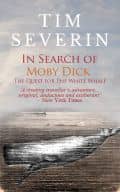Melville’s classic novel Moby-Dick immortalized the idea of a mammoth, battling sperm whale roaming the seas, wreaking havoc on all that crossed its path. But could such a creature exist, then or now?
To find out, Severin travels to Nuku Hiva in the Marquesas Archipelago where the twenty-one-year-old Melville deserted his whaling ship in 1842 and began to cobble together the legends, tall tales, sea lore and first-hand accounts garnered from the whalers he encountered, filtering all this material through his own fertile imagination to create his monumental novel. It is here that Severin begins to perceive the lush weave of fact and fiction, actual experience and extravagant yarn, which became Moby-Dick.
The complex richness of Melville’s tapestry becomes even clearer as Severin sails on throughout the islands of the South Pacific—the Philippines, Tonga, Indonesia—all along the way asking the last surviving whale hunters of the great ocean if they have ever encountered a white whale. He introduces us to real-life characters who seemed to have stepped out of both literature and the distant past: hunters who still use Stone Age boats, hunt the sperm whale by hand and are firm believers in the Great Whale; hook-jumpers who earn their living by jumping on the backs of ten-ton whale sharks, killing them with large, iron, hand-held hooks; a harpooner and priest who re-enacts for Severin the mechanics and mysticism of a whale kill.
In this captivating and illuminating account of his voyage, Severin begins to understand not only the origins of Melville’s legendary literary creation, but also something of the spiritual relationship between the islanders and the creatures of the sea, the hunter and his prey. Even more intriguing is the tantalizing evidence Severin uncovers for the existence of a Great White Whale.
